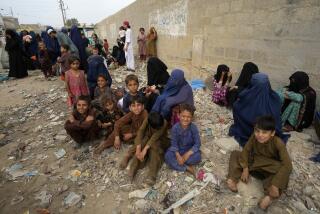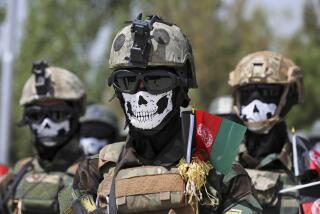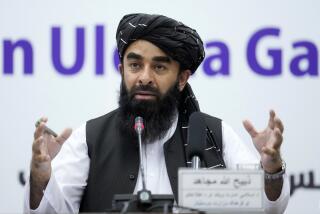Enticements in Plan to Disarm Afghan Militiamen Include Job Training
- Share via
KABUL, Afghanistan — Amid rising violence, the government of President Hamid Karzai and the United Nations formally initiated an ambitious program Sunday to disarm up to 100,000 Afghan militiamen by using economic incentives.
Officials heading a new government entity called Afghanistan’s New Beginnings Program are under no illusions, however, about the difficulty of persuading a reluctant populace to give up weapons that can mean identity, income and self-defense.
Firearms are everywhere in evidence in Afghanistan, a country where the rule of the gun has superseded the legal system during a quarter-century of warfare. Many are toted by the thousands of militiamen on the payroll of the Ministry of Defense. The prevalence of arms is also widely recognized as a threat to security and an impediment to economic recovery.
The program unveiled Sunday had been delayed for weeks, reportedly by differences within the Karzai government over how to implement it. It is bound to ruffle the feathers of many former warlords now in high government positions who want to keep their armed retainers on call.
But in addition to presenting security dangers, the existence of thousands of armed militiamen threatens the credibility of the new Afghan national army, which is now being trained and in theory will replace the various militias over time.
The new program is being funded by the governments of Canada, the United States, Japan and Britain, all of which are putting cash into a trust administered by the U.N. Employees will be mostly Afghans. The program will specifically target militiamen currently paid by the Ministry of Defense.
Yusuf Pashtun, Afghanistan’s minister of housing and urban planning and a member of the commission appointed by Karzai to oversee the program, said it will make available job training, military enlistment opportunities and cash as carrots to induce militiamen to turn over their guns.
Pashtun acknowledged that the agenda is daunting.
“I warn my friends when I talk about Afghans that I’m usually optimistic. I have to be optimistic. Afghans have no experience on such a scale. It will require a lot of preparation and input from all the communities that have experience in this,” Pashtun said.
Disarmament programs in the Serbian province of Kosovo and in Bosnia-Herzegovina may be used as models, he added.
A pilot disarmament program managed by the U.N. and begun last summer in northern Afghanistan, where militants loyal to three rival warlords regularly take potshots at one another, has been only moderately successful. But U.N. special representative Lakhdar Brahimi said Sunday that that program has at least had the effect of reducing tensions in the region.
“This is an important project,” Brahimi said of the new plan. “This is part of the security sector reform, part of what is happening in an effort to create the national army and also the reform of the Ministry of Defense.”
One of the many complications of disarmament in Afghanistan is that while some militiamen will be asked to give up their guns, the U.S. has in the past paid armed militias for help in the war on terrorism and is believed to be still paying some.
Still, Brahimi said: “The Americans are very much part of this project ... and very much into the creation of a national army. They know you can’t have a national army if you don’t dissolve the existing armies. Otherwise you are creating just one more army.”
The disarmament process is scheduled to begin July 10 after two months of staff training and the creation of eight regional offices. Among the regions targeted are the Kabul, Khowst, Bamian, Kunduz and Kandahar areas.
“We are planning operations for one year, but I’m sure that won’t be sufficient. Disarmament is the easy part of it. The re-integration of such a big number [of militiamen] to bring them in and stabilize them and create employment for them will take much longer,” Pashtun said.
More to Read
Sign up for Essential California
The most important California stories and recommendations in your inbox every morning.
You may occasionally receive promotional content from the Los Angeles Times.













